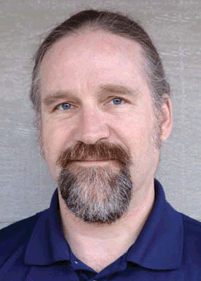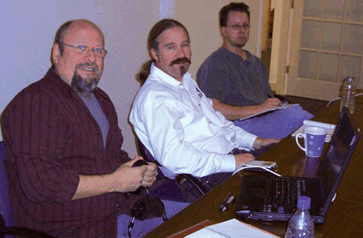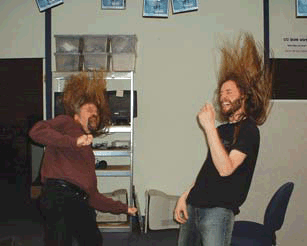Field Work

SCN: You put a unique spin on the ageold art of “busking” while you attended
Dave Gunness the University of Wisconsin Madison in the early 1980s, singing and playing guitar over your own hand-built loudspeakers. Was necessity the mother of invention, or had you always been intrigued by the inner working of electronics?
Dave Gunness: Well, I’ve always been a geek, but the primary motivator there was that I needed equipment I couldn’t afford, so that I could play out, get paid, and convince girls I wasn’t a dweeb. Isn’t that what fuels all young musicians’ careers?
Those homemade speakers weren’t great, but I kept trying to make them better without spending all my beer money. Many years later, not much has changed: I design a product that sounds OK, but is not exactly what I want, figure out what’s wrong with it, and then make it better. Audio is still an endless adventure. Of course, I’ve been married for 24 years and beer money isn’t usually a problem now; so that part is a little easier
SCN: When you launched your loudspeaker design career at Electro- Voice, your patent-earning innovations combined creativity with academic theory. It has been said that you have an ability to overcome design obstacles in your own unique way, cutting a new course for true invention. When you begin a new project, what is the first element in your process?
DG: If there’s a “project”, then there are specific objectives and constraints. The first step is always to understand those—what are the engineering objectives, what market constraints shouldn’t be violated, is a radical solution called for, or would a conservative design be better received? Every project is a new game with a new set of rules. You can waste a lot of time and energy if you don’t bother to learn them.

Audio innovators (from left): Sam Berkow, Dave Gunness, and Jamie Anderson. is right after an acceptable solution is generated. Most engineers will commit to their first good idea, and they never find out how much better their fourth or fifth one would have been. By analyzing a number of possible approaches, you can arrive at a better understanding of the one you eventually settle on. In fact, it’s pretty common for that analysis to clarify your understanding of the original problem, which is where some of the most innovative solutions come from.
While problem solving within the context of product design can be a great source of incremental innovation, it is not a good medium for generating disruptive technology. For that, you have to have an “offline” R&D effort—meaning it isn’t tied to a specific product design. I’ve spent over half of my career working on these off-line research projects, so perhaps it’s not surprising that I seem to “overcome design obstacles in my own unique way,” as you put it. I’ve spent as much time developing tools as I’ve spent using them.
SCN: Upon moving to Eastern Acoustic Works in 1995, you found yourself able to spend more time in the field, working with sound companies, designers, and installers. The results of your work at EAW include the KF900 large-scale sound reinforcement system, the DSA digitally steered array, and a suite of innovative processing techniques marketed as “Gunness Focusing.” What role does hands-on, real-world application play in your product development work?
DG: Having a hands-on approach to product development is absolutely invaluable. Being on site when things go wrong is one of the most important experiences you can have, because you find out what sorts of things can make your customers’ lives miserable, and, as a manufacturer, how not to be the cause of those things.
Customer interaction also reminds me how passionate our industry is about sound quality. It really recharges my batteries to see how excited consultants and integrators get when they hear great results from a system they designed or installed.
A daily selection of the top stories for AV integrators, resellers and consultants. Sign up below.
SCN: Last year you became one of the founders of Fulcrum Acoustic. How did your passion lead you to launch a new endeavor with the purpose of improving the performance of audio equipment by combining advanced signal processing techniques with electroacoustical design principles?
DG: Starting a company is something I’ve been preparing myself for since my first day in the industry. Last year, finally, all the pieces fell into place. I found myself needing a change in my professional situation, the right people were motivated to do it, and the opportunities were there on both the supply side and the demand side. It’s been a great experience so far.
Our emphasis on incorporating DSP into loudspeaker design reflects the shared vision of the company founders—that many of the fundamental performance limitations of loudspeakers can be exceeded by integrating DSP more deeply in the designs.
SCN: How would you complete the following sentences?
The next generation of loudspeakers will... be a little better than this one. That’s how it usually goes. Eventually, though, something really innovative and powerful will come along. That’s also how it goes.

“If the result doesn’t sound the way you expected it to, it probably means you’ve left some important factor out of your analysis.” people will create them; and of course I have a lot of ideas about what tools and techniques are likely to be helpful. But, I can’t say for certain what the innovations will be. If I knew that, I would have done them already.
Design on paper... In my experience, there are no pleasant surprises in loudspeakers. If it works on paper, there’s a chance it will work in reality. If it doesn’t work on paper, forget about it. So there you have it—design on paper is a good way to weed out obviously bad ideas. Of the good ideas, some will work and some won’t; which leads to the importance of...
Prototyping and experimentation... I made a presentation recently on the TQ Install line, and one of the attendees was pleasantly surprised to find that none of this was cut and dried. He thought because there was so much science involved, that the designs would have been done primarily “on paper,” implemented as conceived, and verified by measurement. He was heartened to learn that the process involved listening and revision at every step.
Loudspeaker design is an aesthetic endeavor—or at least it should be. No matter how much science you apply to a problem, you can’t say you’re done until it sounds great. The weakness of scientific analysis is that you can only analyze the factors you’re aware of. If the result doesn’t sound the way you expected it to, it probably means you’ve left some important factor out of your analysis. Troubleshooting underperforming prototypes is how you learn new things about loudspeaker behavior, and is another rich source of innovation.
